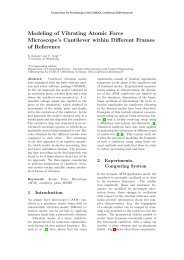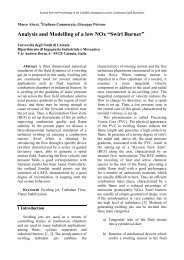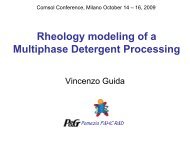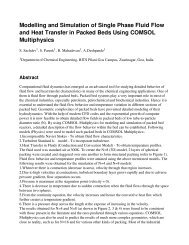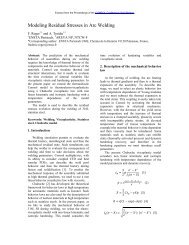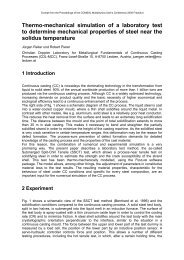Design of Light Emitting Diodes (LED) - COMSOL.com
Design of Light Emitting Diodes (LED) - COMSOL.com
Design of Light Emitting Diodes (LED) - COMSOL.com
Create successful ePaper yourself
Turn your PDF publications into a flip-book with our unique Google optimized e-Paper software.
Excerpt from the Proceedings <strong>of</strong> the <strong>COMSOL</strong> Users Conference 2007 Grenoblewhere J ist the current density, V and V 2 thepotential in the two domains and n 1 and n 2 theideality factors.Figure 3 shows an example for the fitting result.The fitting quality is very good at low currentsand give the fitting parameters n 1 =2 and n 2 =1.2.Beyond 10mA the series resistance isdominating. This region can be modeled by<strong>COMSOL</strong>.Current / A1,E+001,E-021,E-041,E-06measurementFit5. Comparison with the experiment5.1 2D-ModelingFig. 5 shows the excellent agreement <strong>of</strong> thesimulated and measured current-voltagecharacteristic (I-U- characteristic). Because mostmaterial parameters are not well known, one hasto vary the parameters so that the I-Ucharacteristicfits to the experimental result. Fig.5 also shows the I-U-characteristic <strong>of</strong> the p-njunction(fit). The difference between the purejunction characteristic and the measured I-Ucharacteristicresults from the series resistancedue to the contacts and the finite conductivity <strong>of</strong>the spreading layers.1,E-080,6 0,8 1 1,2 1,4 1,6 1,8Voltage / V1,00,8fitmeasurementFig. 3: fitting the current-voltage curve at lowcurrentscurrent / A0,60,4simulationThe next steps are straightforward: We have toenter the contact resistivities and theconductivities <strong>of</strong> the spreading layers. Only for a3-D-simulation we need a third domain for thecontact grid which defines the current-voltagecharacteristicbetween the contact grid and theupper spreading layer:J = ( V V2) / rho _ cont3−where J ist the current density, rho-cont thecontact resistance and V 3 and V 2 the potential inthe contact grid and the upper spreading layer,respectively. Fig. 4 shows an example <strong>of</strong> the 3-Dgeometric layout <strong>of</strong> the <strong>LED</strong> shown in fig. 2.electrical potential0,20,01 1,2 1,4 1,6 1,8voltage / VFig. 5: Current-voltage curve: small-current-fit,measurement and simulationFig. 6 shows the simulated current densitybetween two n-contacts (<strong>com</strong>pare the schematicdrawing in fig. 1c) for three different n-spreadingconductivities together with the measuredradiation density. The current density must besimilar to the radiation density, therefore aqualitative <strong>com</strong>parison is allowed. Differencesare due to diffusion effects <strong>of</strong> the light within thechip. One can see a qualitative agreementbetween simulation and experiment.in<strong>com</strong>ing current flowJ=(V3-V2)/rho_contin<strong>com</strong>ing current flowJ=J01*exp(e*(V2-V)/(n1*kT))+J02*exp(e*(V2-V)/(n2*kT))8 x p-contactFig. 4: 3-D model <strong>of</strong> a <strong>LED</strong>
Excerpt from the Proceedings <strong>of</strong> the <strong>COMSOL</strong> Users Conference 2007 Grenoblecurrent density / a.u.1,00,80,60,40,2n-spreading 1n-spreading 2n-spreading 3measurement25020015010050light density / a.u.An appropriate parameter for a <strong>com</strong>parison withthe experiment is the voltage drop over the n-contact grid which can be easily measured withtwo probes. Fig. 7 shows the <strong>com</strong>parison <strong>of</strong> themeasured and simulated results. For optimumagreement the n-contact resistance had to beslightly reduced and the p-contact resistanceenhanced within a physically reasonable range.n-Kontaktp-Kontaktn-Kontakt0,00-54 -27 0 27 54locationFig. 6: Comparison <strong>of</strong> simulated current densityand measured radiation density5.2 3D-ModelingAfter fitting the material parameters with 2Dsimulations,one can continue with 3Dsimulations.131mV93mV6. Optimisation <strong>of</strong> a <strong>LED</strong>-structureFigure 8 shows the simulated current density inthe p-n-junction for different distances <strong>of</strong> two n-contact lines (different number <strong>of</strong> segments) anddifferent lateral distances <strong>of</strong> the n- and p-contact.The differences are significant. Configuration 1shows a very high current density near the n-contact (current crowding) and configuration 2 ahigh current density over a small area. The bestchoice is configuration 3 with a moderate currentdensity with a good homogeneity.149mV138mV45mV21150mV135mV93mVcurrent density3135mV98mV-54 -40,5 -27 -13,5 0 13,5 27 40,5 54location / µm160mV125mV58mVFig. 8: Simulated current density in the p-njunctionfor different geometric layouts164mV150mV109mVFig. 7: Simulated and measured voltage dropover the n-contact grid. The bondpad in theupper right corner is the reference pointAn example for a 3D-optimization is shown infigure 9. Here the current density in the p-njunctionfor a structure similar to that in figure 2(chip 1) and that <strong>of</strong> an optimized structure (chip2) are plotted. Chip 1 shows current crowdingaround the chip (near the n-contact) and adecreasing current density from the left to theright <strong>of</strong> the chip. Chip 2 shows less area withcurrent crowding and a better uniformity.
Excerpt from the Proceedings <strong>of</strong> the <strong>COMSOL</strong> Users Conference 2007 Grenoblechip 1chip 27. ConclusionsIn this paper a finite element model for thecurrent light intensity distribution across an <strong>LED</strong>chip is presented. The model has beenimplemented in <strong>COMSOL</strong> Multiphysics, using atwo domain approach for the n- and p-layers wita boundary condition containing an effectivecurrent-voltage characteristic for the pn-junction.The simulated quantities are the current-voltagecharacteristic,the current distribution within theactive layer and the voltage drop on the contactgrid. The agreement between the simulated andexperimental results is very good. It is shownthat the uniformity <strong>of</strong> the current distribution inthe active region can be optimised significantlywith the help <strong>of</strong> the simulations.Fig. 9: Current density distribution in the p-njunctionfor two different chip designs





